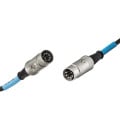- Opis
-
Szczegóły
Waldorf Blofeld Keyboard Black – syntezator wavetable z klawiaturą Fatar
Waldorf Blofeld Keyboard Black to rozszerzona wersja kultowego modułu desktopowego Blofeld, która podniosła instrument na zupełnie nowy poziom. Oprócz tego, że oferuje wszystkie możliwości syntezatora Blofeld, został wyposażony w wysokiej jakości klawiaturę Fatar z 49 półważonymi klawiszami i funkcją aftertouch oraz nową pamięć 60 MB, umożliwiającą korzystanie z próbek audio. Dzięki temu Blofeld Keyboard staje się nie tylko wszechstronnym syntezatorem, ale również quasi-samplerem.
Dziedzictwo i historia syntezy
Blofeld Keyboard czerpie swoje DNA z najważniejszych instrumentów marki Waldorf: Q, Micro Q, Microwave i legendarnego Wave. W praktyce oznacza to połączenie klasycznej syntezy subtraktywnej, syntezy wavetable oraz pracy z próbkami. Inspiracją dla technologii wavetable pozostaje PPG Wave z lat 80., który zapoczątkował nową erę cyfrowej syntezy. Blofeld Keyboard, wzbogacony o pamięć samplera, pozwala tworzyć jeszcze bardziej złożone i realistyczne brzmienia.
Najważniejsze cechy
- 60 MB pamięci na próbki audio
- 25 głosów polifonii
- 16-częściowy multi-timbral
- Ponad 1000 presetów w pamięci
- 3 oscylatory i 2 filtry na każdy głos
- Synteza: Virtual Analog, Wavetable, Sample
- Modulacja częstotliwościowa dla oscylatorów i filtrów
- 3 szybkie LFO i 4 obwiednie na głos
- Zaawansowany arpeggiator
- Rozbudowana sekcja modulacyjna i efektów
- Solidna metalowa obudowa
- Klawiatura Fatar 49 półważonych klawiszy z aftertouch
- Kółka Pitchbend i Modulation
- Możliwość podłączenia pedału sustain
- Duży, podświetlany wyświetlacz LCD 128x64
- 7 metalowych enkoderów typu „endless”
- MIDI In/Out oraz USB MIDI (Windows, Mac OSX, Linux)
- Wewnętrzny zasilacz sieciowy
Nowy poziom samodzielności
Dzięki dodatkowej pamięci 60 MB, Blofeld Keyboard umożliwia załadowanie własnych próbek audio i traktowanie ich jak klasycznych oscylatorów. W połączeniu z filtrami, obwiedniami, LFO i efektami instrument zyskuje ogromne możliwości kreacyjne. To rozwiązanie sprawia, że staje się pełnoprawnym samodzielnym instrumentem scenicznym i studyjnym.
Zastosowania
Blofeld Keyboard to syntezator stworzony zarówno dla producentów muzyki elektronicznej, jak i dla klawiszowców koncertowych. Jego wszechstronność sprawdza się w gatunkach takich jak techno, house, ambient, filmowe soundtracki czy rock. Możliwość wykorzystania własnych próbek daje swobodę kreowania unikalnych brzmień, a zaawansowany arpeggiator i modulacje czynią go świetnym narzędziem live.
Materiały i konstrukcja
Instrument charakteryzuje się solidną, metalową obudową i wysoką jakością wykonania typową dla produktów Waldorf. Klawiatura Fatar zapewnia doskonałą kontrolę i komfort gry, a duży wyświetlacz LCD ułatwia pracę w każdej sytuacji. Kompaktowy rozmiar i eleganckie czarne wykończenie czynią go zarówno praktycznym, jak i efektownym elementem każdego setupu.
Dołączone w zestawie
- Waldorf Blofeld Keyboard Black
- Kabel zasilający
- Instrukcja obsługi
Podsumowanie
Waldorf Blofeld Keyboard Black to instrument, który łączy historię i innowację. Oferuje moc syntezy wavetable, obsługę próbek, ponad tysiąc brzmień i świetną klawiaturę Fatar. To wszechstronny syntezator, idealny do studia i na scenę – doskonały wybór dla muzyków poszukujących narzędzia z najwyższej półki w rozsądnej cenie.
- Dostawa
-
Szczegóły dostawy produktu Waldorf Blofeld Keyboard Black - Syntezator
Wysyłka z Warszawa, Polska.
Dostawa do
Jeżeli chcesz zobaczyć dokładne metody dostawy dostępne w Twojej lokalizacji, uzupełnij powyższe pola.
- Zadaj pytanie
-
Zadaj pytanie odnośnie produktu
- Produkt faq
-
Waldorf Blofeld Keyboard Black - Syntezator - Najczęściej zadawane pytania.
Czym różni się Blofeld Keyboard od wersji desktop?
Posiada klawiaturę Fatar 49 półważonych klawiszy z aftertouch oraz 60 MB pamięci na próbki.
Ile głosów polifonii oferuje Blofeld Keyboard?
Maksymalnie 25 głosów.
Czy można ładować własne próbki?
Tak, instrument posiada 60 MB pamięci do pracy z próbkami audio.
Ile brzmień fabrycznych jest dostępnych?
W pamięci znajduje się ponad 1000 presetów, które można edytować i uzupełniać własnymi próbkami.
Czy Blofeld Keyboard posiada arpeggiator?
Tak, ma rozbudowany, programowalny arpeggiator.
Jakie rodzaje syntezy obsługuje?
Virtual Analog, Wavetable oraz Sample Playback.
Jakie złącza oferuje instrument?
MIDI In/Out, USB MIDI, wyjścia audio stereo i wyjście słuchawkowe.
Czy można podłączyć pedał sustain?
Tak, Blofeld Keyboard posiada wejście dla pedału sustain.
Czy instrument sprawdzi się w muzyce na żywo?
Zdecydowanie tak – klawiatura Fatar, solidna obudowa i szerokie możliwości modulacyjne czynią go idealnym na scenę.
Kto powinien wybrać Blofeld Keyboard?
Producent muzyki elektronicznej, klawiszowiec koncertowy, kompozytor filmowy – każdy, kto potrzebuje wszechstronnego narzędzia brzmieniowego.
- Recenzje (1)
-
5.0 / 5
1 recenzja
Recenzje klientów
-
Jakość Trwałość Wygląd Cena Waldorf Blofeld Keyboard Black to prawdziwe arcydzieło wśród syntezatorów. Jakość wykonania jest na najwyższym poziomie, co widać w każdym detalu. Klawiatura półważona 4-oktawowa zapewnia świetne czucie podczas gry. Brzmienie jest charakterystyczne dla Waldorfa - bogate, ciepłe i przestrzenne. Wbudowany moduł samplerowy z 60MB pamięci to duży plus. Stosunek jakości do ceny jest bardzo dobry, choć cena może być barierą dla początkujących muzyków. Polecam szczególnie profesjonalistom i entuzjastom syntezatorów.
-
-
O producencie Waldorf

Firma Waldorf Music GmbH została założona w roku 1988 przez Wolfganga Dürena. Siedziba firmy Waldorf Music GmbH znajduje się w Waldorf (D).
Produkty firmy Waldorf produkowane są wyłącznie w Niemczech.
Firma
- Siedziba producenta: Niemcy
- Średnia ocena produktów: 5.0
Produkty
- Liczba produktów: 17
- Liczba dostępnych produktów: 10



















